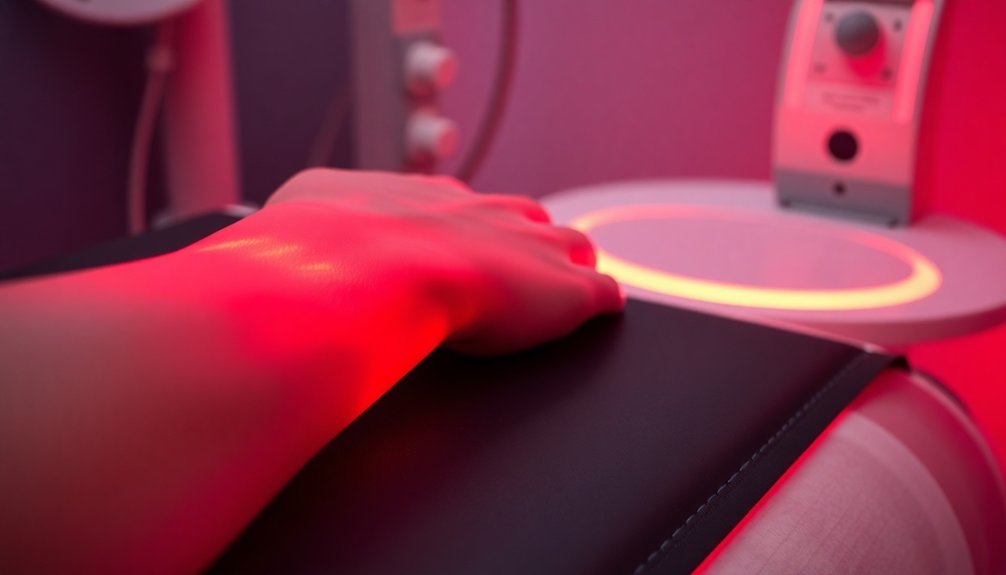Near-infrared light therapy speeds up your bone recovery in three key ways. First, it penetrates deep into your tissue to activate cellular repair mechanisms, boosting ATP production and stimulating the cells responsible for bone formation. Second, it enhances blood flow to your injury site, delivering essential nutrients and oxygen while removing waste products more efficiently. Third, it directly improves bone density by increasing osteoblast activity and promoting better mineralization of bone tissue. These natural healing processes work together to accelerate your recovery time and strengthen bones. Understanding how NIR therapy targets each mechanism can help you maximize its benefits.
Cellular Repair Through Light

Light's remarkable ability to repair bone cells operates through a sophisticated process called photobiomodulation. When NIR light penetrates your tissue, it targets the mitochondria in each cell, triggering a cascade of healing responses that accelerate bone recovery.
Your cells respond to NIR light therapy by ramping up their metabolism and energy production. This increased cellular activity stimulates vital bone-forming cells called osteoblasts, while also activating fibroblasts that produce collagen and endothelial cells that form new blood vessels. Multiple treatment sessions over time are typically needed for optimal healing outcomes.
The process reduces inflammation by regulating cytokine levels and calming inflammatory cell activity.
You'll benefit from enhanced callus formation during the early healing stages, which helps stabilize your fractured bones. The light therapy also increases collagen deposition and bone density, making your healed fractures stronger.
Different wavelengths target specific healing needs – for instance, 830nm works well for wrist and hand fractures, while 635nm helps with dental implant stability.
Through this cellular repair process, you're getting thorough bone healing support. The therapy kick-starts your body's natural regenerative mechanisms, promoting faster and more efficient bone recovery while reducing pain and inflammation.
Improved Blood Flow
How does NIR therapy enhance bone healing? The answer lies in its remarkable ability to improve blood circulation within bone tissue.
When you undergo NIR treatment, the light penetrates deep into your bones, stimulating blood vessel formation and enhancing oxygen delivery to damaged areas. This increased blood flow carries essential nutrients and healing factors directly to the injury site, accelerating your recovery process.
Traditional methods like PET and MRI scans face significant limitations in assessing bone blood flow. NIR's powerful effects on bone circulation include:
- Triggers post-occlusive reactive hyperemia, allowing doctors to measure your vascular health and recovery potential
- Boosts oxygen levels in skeletal muscle and bone tissue, promoting faster healing
- Enhances reperfusion rates after temporary blood flow restrictions
- Stimulates the formation of new blood vessels, vital for long-term bone repair
Your body's natural healing mechanisms work more efficiently with improved circulation. NIR therapy doesn't just temporarily increase blood flow – it helps create lasting improvements in bone vasculature. This is particularly beneficial if you're over 50, as bone reperfusion capacity naturally declines with age.
The enhanced hemodynamics from NIR treatment can help overcome this age-related limitation, supporting better bone healing outcomes regardless of your age.
Bone Density Enhancement

NIR therapy's impact on bone density represents a groundbreaking advancement in regenerative medicine. Through specific wavelengths like 660nm, 810nm, and 830nm, NIR treatment activates essential cellular mechanisms that enhance your bone's regenerative capacity. You'll benefit from increased osteoblast activity and improved mineralization, which directly contributes to stronger, denser bones.
When you undergo NIR therapy, it triggers several beneficial molecular pathways. The treatment stimulates your mesenchymal stem cells through the ROS/HIF-1α pathway, promoting both angiogenesis and cell differentiation. You'll also experience enhanced β-catenin translocation to the nucleus and reduced inflammation through decreased NF-kB concentration. These processes are essential for ideal bone healing and regeneration.
Clinical studies have shown you can expect improved bone density and faster healing across various types of fractures. Traditional imaging methods like X-rays and MRI often struggle to track early bone healing progress. If you're dealing with osteoporosis, NIR therapy can help restore bone mass while reducing inflammation.
While it's not a standalone treatment for bone conditions, you'll find it's an effective complementary therapy to traditional treatments. The non-invasive nature and minimal side effects make it an attractive option for supporting your bone recovery journey.
Frequently Asked Questions
How Long Does a Typical NIR Treatment Session Last?
Your NIR treatment session will typically last between 10 to 20 minutes. You'll usually receive multiple sessions per week, though the exact duration can vary based on your specific condition and protocol.
Can NIR Therapy Be Harmful if Used Too Frequently?
Yes, you can harm yourself through overuse of NIR therapy. You'll risk skin burns, increased oxidative stress, and reduced therapeutic benefits. It's best to follow professional guidelines and avoid excessive treatments for ideal results.
What Is the Recommended Distance Between the NIR Device and Skin?
You'll generally want to keep your NIR device 1-5 cm from your skin, but always check your device's manual first since the ideal distance varies by manufacturer and wavelength specifications for safe, effective treatment.
Is NIR Treatment Covered by Health Insurance for Bone Recovery?
You won't typically get insurance coverage for NIR treatments for bone recovery. Most insurance companies, including Medicare and Aetna, don't cover it due to limited scientific evidence supporting its effectiveness in bone healing.
Can NIR Therapy Help With Bone Recovery While Wearing a Cast?
While you're wearing a cast, NIR therapy's effectiveness is limited since the cast blocks direct access to your fracture site. You'll get better results if you wait until after cast removal to start treatment.
In Summary
You'll find these three near-infrared treatment benefits work together to accelerate your bone healing journey. The cellular repair stimulation, enhanced circulation, and strengthened bone density offer you a thorough recovery approach. Whether you're dealing with a fracture or recovering from surgery, NIR treatment can help you get back on your feet faster and with better healing outcomes.





Leave a Reply